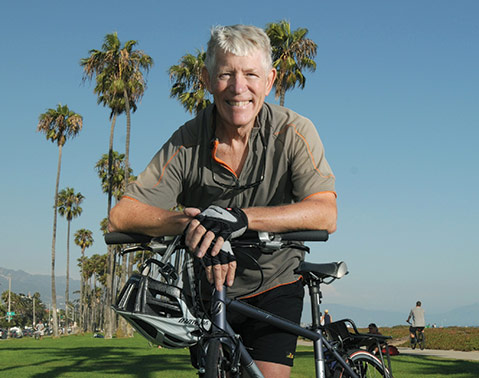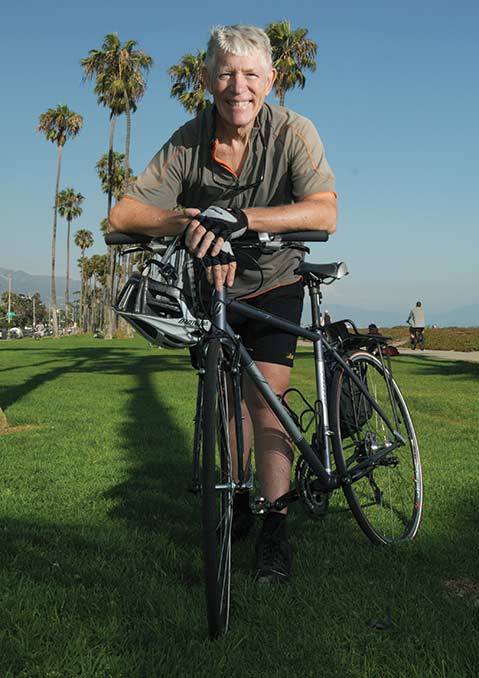
On July 18, 2014, the day the Santa Barbara Bicycle Coalition closed on its Haley Street building, Ralph Fertig passed away. A founding member of the coalition, the father of the coalition’s Quick Release newsletter, and a tireless advocate, Ralph will forever remain at the heart of our cycling community.
Ralph became known during the mid-1980s as an effective spokesperson for trails and bike lanes. “If any kind of bike-related issue was at stake,” remembered Kent Epperson of the county’s Traffic Solutions, “Ralph was there.” In 1991, Ralph joined a group of cyclists who were working to improve local conditions and, within a few months, the group became the Santa Barbara Bicycle Coalition. Ralph served as president of the Bicycle Coalition for most of the next two decades.
Ralph also started Quick Release, a monthly newsletter he published for the next 20 years — a total of 240 issues — that became the voice of the bicycle community and a powerful force on behalf of pedestrian and bicycle safety. The newsletter reflected Ralph’s passion for art and photography, a love honed during work for his academic degrees, which included art and architecture as an undergraduate at Penn State, painting and ceramics at the Cranbrook Academy of Art in Michigan, and then a master’s degree in mathematics at the University of Michigan and a master’s degree at Chicago Institute of Design, which included a stint with Ansel Adams. After he moved permanently to California, Ralph also taught photography at Cal State Northridge, UCLA, and UC Berkeley.

Ralph was one of the founders of Grassroots 101, the group that successfully opposed the freeway widening south of Milpas in 1993 and directed the funding toward multimodal improvements in the 101 corridor instead. This redirected funding widened North Jameson Lane in Montecito, specifically for bike lanes, and constructed the Class I bike path over Ortega Hill (between Montecito and Summerland). These two expensive and critically needed projects likely would not exist today if Ralph, ever thorough with data, hadn’t patiently reminded us that most daily trips are shorter than two miles and, in its very essence, “all transportation is local.”
The quality of Ralph’s testimony in front of city, county, and the Santa Barbara County Association of Governments (SBCAG) was legendary. He was well prepared, polite, succinct, and accurate. Governmental organizations, the press, and members of the public came to know this, and even those who might disagree with Ralph still liked and respected him. Dru van Hengel, formerly the city’s mobility coordinator, remembered Ralph as “tireless, passionate, optimistic, and a little pesky.” He didn’t let an issue go. “Yet on the other hand,” she recalled, “he was reasonable — so reasonable policymakers would ask, ‘What is Ralph’s position on this?’”
Ralph always spoke in public with an informed, graceful, and, above all, respectful manner. “Ralph constantly surprised me with his calm approach to those who don’t understand cyclists,” said Don Lubach, a member of the Bicycle Coalition and assistant dean of students at UCSB. Recalling times when the bike community felt under attack, Lubach said, “Ralph would quietly remind us to imagine why a project, opponent, or angry letter writer was so passionate.”
Ralph was also patiently persistent in dealing with bureaucracy. He attended most of the 100-plus meetings and hearings that led to the adoption of Santa Barbara’s new Circulation Element, a document that changed forever our culture of automobile dependency. He effectively participated in ad hoc committees advising SBCAG on projects along the Highway 101 corridor in Santa Barbara County and Caltrans on the widening of Highway 101 in Ventura County. He attended dozens of Caltrans meetings throughout Southern California to advocate for the recently completed Class I bike path along Highway 101 between Rincon and Mussel Shoals.
Ralph was a world traveler and keen to ride a bicycle in faraway places like Egypt and Cambodia. He documented his adventures in well-written and beautifully illustrated Christmas newsletters that will be missed this holiday season by his many friends. He was also a very active gardener, and visitors to his home rarely left without a few avocadoes, some lemons, or vegetables he had grown. Lubach recalled touring Ralph’s hillside garden: “We felt like we were on a climbing adventure with a brilliant park ranger.” Bicycle Coalition meetings at Fertig’s house are a part of his legacy. Van Hengel, an early coalition member, enjoyed Fertig’s inclusion of her young son, who accompanied her to noontime meetings. “He was sweet and considerate of my blossoming bike advocate,” she said.
Ralph’s vision was limitless, recalled van Hengel. He wanted to improve bicycle access, add facilities and programs, and increase the number of riders of all ages and abilities. Noting Fertig’s world travels, Lubach said, “I believe his vision was constructed as sort of an urban planner’s plate of dim sum — one of these, a couple of those … He wanted to bring civility and wonder to Santa Barbara.”
